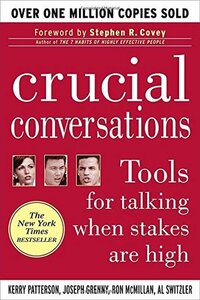Take a photo of a barcode or cover
708 reviews for:
Crucial Conversations: Tools for Talking When Stakes Are High
Ron McMillan, Kerry Patterson, Al Switzler, Joseph Grenny
708 reviews for:
Crucial Conversations: Tools for Talking When Stakes Are High
Ron McMillan, Kerry Patterson, Al Switzler, Joseph Grenny
I skipped the annoying self-satisfied introductions and forwards and it was still difficult to read the first few chapters. Once the material got more specific instead of just promising I would be awesome, it was good. However, it took almost half the book for it to get good.
I still would have liked their examples to have been more specific. We are social creatures and we learn through social modeling, i.e., watching others do things. I also found it annoying that they made up terms like "fool's choice" instead of using already-existing terms like "false dichotomy" (maybe they wanted to make it more approachable?). Other made-up terms were kind of annoying, but I recognize they were trying to make the ideas stick in my head.
The concepts in this book for opening up sincere dialogue are excellent. When someone else gets defensive, it's a sign that they don't feel safe in the conversation. I can help them feel safer by clarifying our common goals (if we have one) and accepting their opinion respectfully. Next time I get into a tense discussion I hope I can use some of these techniques. However, I tend to be the obliviously offending party so it's more likely that someone else will use these techniques on me.
I still would have liked their examples to have been more specific. We are social creatures and we learn through social modeling, i.e., watching others do things. I also found it annoying that they made up terms like "fool's choice" instead of using already-existing terms like "false dichotomy" (maybe they wanted to make it more approachable?). Other made-up terms were kind of annoying, but I recognize they were trying to make the ideas stick in my head.
The concepts in this book for opening up sincere dialogue are excellent. When someone else gets defensive, it's a sign that they don't feel safe in the conversation. I can help them feel safer by clarifying our common goals (if we have one) and accepting their opinion respectfully. Next time I get into a tense discussion I hope I can use some of these techniques. However, I tend to be the obliviously offending party so it's more likely that someone else will use these techniques on me.
hopeful
informative
reflective
medium-paced
This book provides an excellent model for handling "crucial" conversations. A crucial conversation is any conversation where stakes or emotions may be high.
The model presented is easy to understand but is difficult to put into practice. This is actually a strength of the model. Fundamentally, this model is not a quick fix or a prescriptive "follow these steps and get these results" approach. Rather, it's a perspective on communication that will, if properly applied, fundamentally change your mindset in crucial conversations.
The conversation model presented in this book has many parts, but there are two fundamental principles.
"Learn to Look": Observe whether or not the conversation is in dialogue or if it's moving toward argument or avoidance. Getting into the habit of observing the state of the conversation will help keep it in dialogue.
"Make It Safe": When you observe a conversation moving away from dialogue, take action to make it safer. The book discusses specific techniques, but anything to step back from discord will help.
Overall, this is a highly practical book that I expect to revisit many times.
The model presented is easy to understand but is difficult to put into practice. This is actually a strength of the model. Fundamentally, this model is not a quick fix or a prescriptive "follow these steps and get these results" approach. Rather, it's a perspective on communication that will, if properly applied, fundamentally change your mindset in crucial conversations.
The conversation model presented in this book has many parts, but there are two fundamental principles.
"Learn to Look": Observe whether or not the conversation is in dialogue or if it's moving toward argument or avoidance. Getting into the habit of observing the state of the conversation will help keep it in dialogue.
"Make It Safe": When you observe a conversation moving away from dialogue, take action to make it safer. The book discusses specific techniques, but anything to step back from discord will help.
Overall, this is a highly practical book that I expect to revisit many times.
I think this book is a fantastic how-to on handling hard conversations. I learned a lot from this and have already started applying some. However, it did get a bit repetitive in chapters
I wish I had read this book many years ago... the advice is practical, useful and direct. I highly recommend this to anyone.
An essential read for anyone in a leadership position
The advice is 4 stars but I had to knock a star off for the gimmicks which make it harder to remember, unclear or unfinished advice, and no tips for power imbalances or bias.
informative
reflective
Everyone would benefit from the conversational strategies presented in this book, both professionally and personally.



